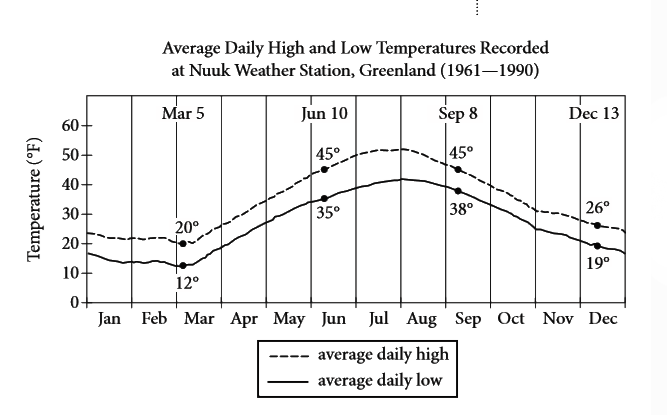Dark Snow
Most of Greenland’s interior is covered by a thick layer of ice and compressed snow known as the Greenland Ice Sheet. The size of the ice sheet fluctuates seasonally: in summer, average daily high temperatures in Greenland can rise to slightly above 50 degrees Fahrenheit, partially melting the ice, in the winter, the sheet thickens as additional snow falls, and average daily low temperatures can drop to (12) .

Typically, the ice sheet begins to show evidence of thawing in late (13) several weeks of higher temperatures. 14 , in the summer of 2012, virtually the entire Greenland Ice Sheet underwent thawing at or near its surface by mid-July, the earliest date on record. Most scientists looking for the causes of the Great Melt of 2012 have focused exclusively on rising temperatures. The summer of 2012 was the warmest in 170 years, records show. But Jason (15) professor of geology at Ohio State believes that another factor added to the early (16) , the “dark snow” problem.
According to Box, a leading Greenland expert, tundra fires in 2012 from as far away as North America produced great amounts of soot, some (17) drifted over Greenland in giant plumes of smoke and then (18) as particles onto the ice sheet. Scientists have long known that soot particles facilitate melting by darkening snow and ice, limiting (19) ability to reflect the Sun’s rays. As Box explains, “Soot is an extremely powerful light absorber. It settles over the ice and captures the Sun’s heat.” The result is a self-reinforcing cycle. As the ice melts, the land and water under the ice become exposed, and since land and water are darker than snow, the surface absorbs even more heat, which (20) .
[1] Box’s research is important because the fires of 2012 may not be a one-time phenomenon. [2] According to scientists, rising Arctic temperatures are making northern latitudes greener and thus more fire prone.[3] The pattern Box observed in 2012 may repeat (21) , with harmful effects on the Arctic ecosystem. [4] Box is currently organizing an expedition to gather this crucial information. [5] The next step for Box and his team is to travel to Greenland to perform direct sampling of the ice in order to determine just how much the soot is contributing to the melting of the ice sheet. [6] Members of the public will be able to track his team’s progress—and even help fund the expedition—through a website Box has created. (22)
22. To make this paragraph most logical, sentence 4 should be placed
where it is now.
after sentence 1
after sentence 2
after sentence 3
The correct Answer is:D
because sentence 5 describes the information Box seeks: “to determine just how much the soot is contributing to the melting of the ice sheet.” Unless sentence 4 comes after sentence 5, readers will not know what the phrase “this crucial information” in sentence 4 refers to.
Choices A, B, and C are incorrect because each results in an illogical sentence progression. None of the sentences that would precede sentence 4 provides details that could be referred to as “this crucial information.”
Similar Questions
एक लोहे की वास्तु को संक्षारण से बचने के लिए कोबाल्ट से आवृत क्या है | क्या कोबाल्ट लोहे की रक्षा केथोड़ीय सुरक्छा के रूप में करेंगा ? समझाइये |
View Solutionछलकता सेल में इलेक्ट्रोड सूक्षम विभाजित प्लेटिनक ब्लेक की परत से आवृत करते है, क्यू ?
View Solutionराजू और उसके पिताजी नदी में नाव से जा रहे थे | राजो के पिता जी ने घडी में प्रयुक्त सेल तथा सावन यंत्र नदी में फेक दिए| राजूने अपने पिता को ऐसा करने से रोका
रासायनिक विज्ञान के विधार्थी होने के नाते आप राजू के पिताजी को नदी में सेल नहीं फेकने को क्योँ कहेंगे |
View SolutionHe+ के इलेक्ट्रॉन के पाए जाने की सर्वाधिक प्रायिकता वाली त्रिज्या पीकोमीटर में है-
View Solutionक्या आप बता सकते हैं कि प्रतिवेदक (रिपोर्टर) एन्जाइम को वरण योग्य चिन्ह की उपस्थिति में बाहरी DNA को परपोषी कोशिकाओं में स्थानांतरन के लिए मॉनिटर करने के लिए किस प्रकार उपयोग में लाया जा सकता हैं ?
View Solutionरामू एक सब्जी उत्पादर हैं । वह अपने उपजाऊ भूमि में टमाटर लगाकर उच्च पैदावर प्राप्त करता हैं । लेकिन उसके खेत से मण्डी की दूरी अधिक थी तथा परिवहन के साधन भी उपलब्ध नहीं थे , जिसके परिमाणस्वरुप विलंब के कारण टमाटर सड़ जाते थे तथा बाजार में मूल्य नही मिलते थे ।
जब उसने कृषि विश्वविद्यालय में पढ़ने वाले अपने मित्र को समस्या से अवगत कराया तब मित्र ने उसे पारजीनी टमाटर की किस्म उगाने को कहा जो कि विलम्ब से पकता हैं ।
उपर्युक्त गद्यांश को ध्यानपूर्वक पढ़ने के बाद निम्न - लिखित प्रश्नों के उत्तर दीजिये - (i) पारजीनी (Transgenic) क्या हैं ?
(ii) पारजीनी टमाटर का उत्पादन कैसे किया जाता हैं ?
(iii) रामू के मित्र व्दारा किन मूल्यों का प्रदर्शन किया गया ?
View Solutionक्या आप दस पुनर्योगज प्रोटीन के बारे में बता सकते हैं जो चिकित्सीय व्यवहार के काम में लाये जाते हैं ? पता लगाइये कि वे चिकित्सीय औषधि के रुप में कहाँ प्रयोग किए जाते हैं ?
View Solutionपृथ्वी के फेफड़े के रूप में किसे जाना जाता है ?
View Solution
